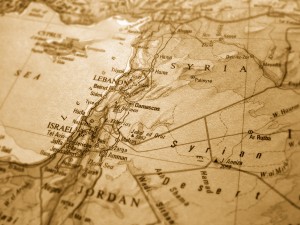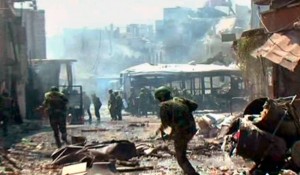2012-08-06 by Ed Timperlake
And so it begins, yet again:
“President Barack Obama has signed a secret order authorizing U.S. support for rebels seeking to depose Syrian President Bashar al-Assad and his government, U.S. sources familiar with the matter said.
Obama’s order, approved earlier this year and known as an intelligence “finding,” broadly permits the CIA and other U.S. agencies to provide support that could help the rebels oust Assad.”(Mark Hosenball, Reuters, August 1st 2012)
Combining a much need “finding” if only to figure out exactly who are the Syrian rebels with operational authority to engage on identifying very bad weapons is a very smart Administration move. This unfortunately was not the case in the “ready fire aim” engagement in Libya with operation Odyssey Dawn.
This time America can be ahead of events and not reactive because of evolving and focused intelligence community engagement.
Especially worrisome are chemical munitions.
The American media, sparked by the breaking news of WSJ story last week, have suddenly discovered and become concerned about large stores of chemical weapons in Syria. U.S. intelligence is anxious that they be safeguarded from use either by the Assad forces or by Syrian insurgents. US assets on the ground in Syria are scant, but fortunately General David Petraeus, the current CIA chief, had a penchant for tracking such weapons during his tours in Iraq, which should serve U.S. interests well in Syria.

The Russians have been involved in these weapons from the time they assisted in the removal of chemical warheads from Iraq.
And Russian and American interests continue to diverge in Syria, with or without, a reset. Credit Image; Bigstock
No one, however, is focused on the significantly out sized nature of those stockpiles or where they came from. Significant amounts of Syrian ordinance originally came from Russia and the inventories are now so large because they included chemical weapons the Russians had sold to Iraq and which they helped get out of the country during the run-up to the 2003 invasion.
The press convinced themselves in 2004 and afterward that, despite considerable evidence to the contrary, Saddam Hussein had eliminated chemical weapons from his arsenal by the time of the invasion.
In fact, all Saddam had done was disperse them, first to new locations in Iraq and then, with Russian help, to various locations in Syria.
In addition to his chemical weapons, Saddam had an inventory of conventional explosives and high-end explosives that was disproportionately comparable to the stockpile of the United States, given the relatively small size of Iraq. These too were sequentially dispersed around the country but both were systematically taken out of the country by convoys of trucks driven by Russian speznaz troops out of uniform, and by cargo planes flying out of Baghdad.
This was a months-long effort directed by KGB General Yevgeni Primakov, the former chief of Middle East arms sales for the Soviets, and later foreign minister and prime minister in the new regime.
It began in December, 2002, and was completed by the time of the Iraq invasion in March, 2003.
The Russians had provided most of these weapons to Saddam (as they had to their parallel client Assad in Syria) and they were anxious to both preserve those stockpiles and to cover up their responsibility for providing them.

The Russian role in the movement of both the chemical and high-end munitions was surfaced by a small unit at the Pentagon called the Office of International Technology Security, which was headed by Dr. John A. Shaw, who was a former Senate-confirmed Inspector General and had spent most of the previous thirty years working on international export controls and on the Middle East.
Because of his IG background he developed an agreement with the DOD IG in 2001 to simultaneously become the Director of International Armament and Technology Trade with the reach of the IG’s office in that area. He was an acknowledged expert on munitions sales and on the arcane underpinnings of arms trade — the players and the practices– in the region.
Because of that, Shaw was also asked to make his bureau the oversight office for transportation and communications problems in the rebuilding of Iraq. His overlapping responsibilities and the depth of expertise in his office provided him a unique opportunity to investigate the emerging problems the US was encountering in Iraq, particularly regarding the weapons and technology found there. In fact DUSD Shaw and his team visited the 101st in Mosul, Iraq when then MG Petraeus was CG.
Shaw had a relationship with Secretary of Defense Donald Rumsfeld, which went back to Rumsfeld’s first tour as Secretary of Defense in 1975, and the position of Deputy Undersecretary for International Technology Security was created in 2001 especially for him.
Shaw knew the turf and had no political or policy agenda beyond finding weapons and munitions in Iraq that were not supposed to be there, and identifying those criminal syndicates and nations responsible for providing them. In that effort he surfaced illegal Chinese involvement in the development of the Iraqi cellular phone system, and Russian participation in the provision of WMD to Saddam and in their stealthy dispersal to Syria.
Shaw’s ability to track the Russian movement of weaponry out of Iraq was amplified by cooperative efforts with British operatives he located along the convoy route, which provided not only the timing of fully loaded trucks going north to Syria, but their subsequent return empty later. They identified three specific locations in Syria that received the chemical weapons, locations which were later publicly revealed by a letter and Dutch journalist in 2004 “De Telegraff” and then pulled off the web. However, NewsMax picked it up.
The movement of these same convoys were tracked by satellite and confirmed by General James Clapper, now the Director of National Intelligence, but then the Director of the National Geophysical Intelligence Agency. Israeli intelligence provided the same confirmation, with General Moshe Ya’alon telling a journalist that Saadam “had transferred the chemical weapons from Iraq to Syria.” The Israelis, as statements by a leading general and intelligence figure In recent days indicate, have continued to track the whereabouts of those weapons, and were able to confirm that they remained in the control of the Syrian army.
The broad involvement of the Russian supervision of the removal of the chemical munitions was provided by Ukrainian intelligence.
Ukraine was a member of the anti-Saddam coalition, and Igor Smeshko, the head of Ukrainian intelligence, had a relationship with General Clapper that went back a decade. Through a Ukrainian-American contact of Shaw’s and through Shaw’s relationships with senior figures in British intelligence, a meeting was arranged in London in April, 2004 with Smeshko, and with Clapper in attendance. That meeting subsequently led to Shaw’s acquiring a detailed inventory of the speznaz units sent to Iraq, dates of arrival and departure, as well as the interim command structure under Primakov. Smeshko subsequently made five trips to the US.
The measure of Primakov’s and the Russians’ success in erasing all traces of the weaponry and their role in its removal was the myth propagated in the Western press that it had never existed.
Primakov’s vehement denial of his role, however, was offset by photographs of two of his generals receiving medals from Saddam Hussein for their role in the removal of the weapons.
American reluctance to give credence to the Russian role, however counter intuitive that appears, may have reflected an anticipated Russian quid pro quo for US silence.
So this story from Ion Mihai Pacepa, a Romanian, the highest-ranking intelligence officer ever to have defected from the former Soviet block who laid it all out never had what is called “legs”.
Consequently, despite the overwhelming evidence, the Russians were never called on the carpet for an effort, which created a future threat of huge dimensions to U.S. interests in the region.
Russian interests in Syria now continue to diverge from U.S. concerns just as strongly as they did a decade ago in Iraq.

